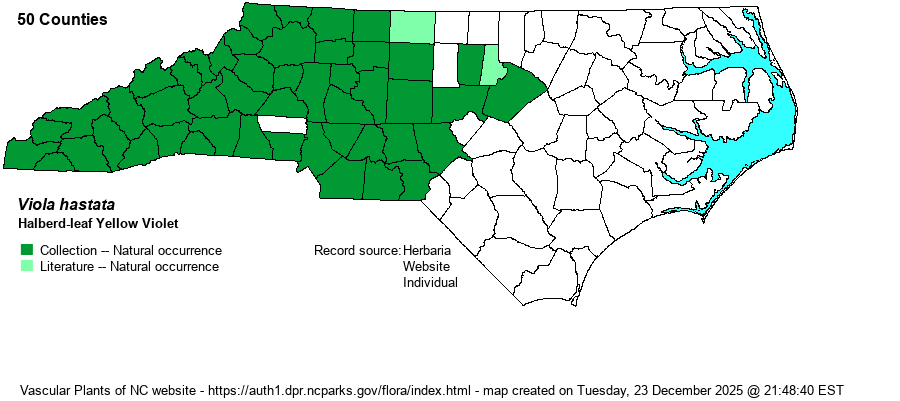| Author | Michaux | |
| Distribution | Throughout the Mountains and most of the Piedmont, but absent from the northeastern portions of the latter province. Ranges east to Rockingham and Wake counties.
This is primarily an Appalachian species, spreading to adjacent regions. It ranges from central PA and eastern OH south to AL and MS.
| |
| Abundance | Frequent to common in the Mountains and western half of the Piedmont. Uncommon to locally fairly common in the southeastern Piedmont. Does not range into the Coastal Plain or Sandhills. | |
| Habitat | This is an upland forest species, growing in mesic to rich forests, but in acidic soils. It also occurs in rocky woods, though mostly found in Mesic Mixed Hardwood Forests and Acidic Cove Forests, as well as several oak forest types. | |
| Phenology | Blooms from late March to May, and fruits shortly after flowering. | |
| Identification | This is one of only several caulescent yellow-flowered violets in the state, easily identified by its leaves. The stem reaches about 6-8 inches tall, and about 2/3rds to the top grow several leaves, generally emerging near the same place, with the last few inches topped by the several flowers on long stalks. The leaves are strongly triangular with a long and tapering tip, about 3 inches long and half as wide (at the base), with the upper surface pale green with deep green veins (as in leaves of Hexastylis arifolia). The flowers are medium yellow, similar to other yellow-flowered species. V. glaberrima is rather similar, with triangular leaves coming off the upper part of the stem. However, the leaves are bright green above with no pale green blotches, and the shape features a broadly rounded to tapered leaf base, as opposed to cordate to hastate in V. hastata. Unlike many violets, V. hastata does not grow in dense stands, but is somewhat scattered, but in the western part of the state it is frequently encountered on spring season forest walks. | |
| Taxonomic Comments | None
General note on Viola: In 2009-10 B.A. Sorrie (website map editor) went through the whole collection at NCU, annotating all specimens against those verified by experts in the genus. The range maps in RAB (1968) have been changed accordingly. More recently, Harvey Ballard and colleagues are in the process of revising all Eastern and Southeastern Viola, and have annotated all specimens at NCU in July 2024. They recognize additional species not in RAB or in previous editions of Weakley et al.; we will follow updated editions of Weakley et al. in recognizing them. Species range maps have been adjusted to account for identification changes. | |
| Other Common Name(s) | Halberd-leaf Violet, Spearleaf Violet, Silverleaf Violet | |
| State Rank | S5 | |
| Global Rank | G5 | |
| State Status | | |
| US Status | | |
| USACE-agcp | FACU link |
| USACE-emp | UPL link |

